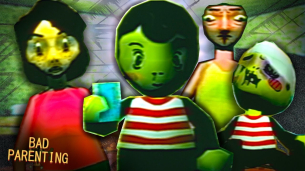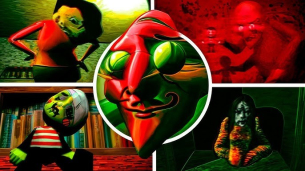When I first started playing Bad Parenting 1: Mr. Red Face, I was immediately intrigued by its unconventional premise. As I dove into the gameplay, I felt both amused and challenged. My experience began with an overwhelming curiosity about the way the game portrayed the theme of parenting through a caricatured lens. From the outset, I found that the game demanded a mix of strategy and empathy, where each decision I made contributed to the unpredictable narrative unfolding before me. The introductory moments were laid out in a quirky cinematic sequence that immediately set the tone, leaving me ready to explore the world of mismanaged responsibilities and comical chaos.
Encountering Unorthodox Narrative Styles
The narrative of Mr. Red Face is unlike anything I have experienced before. The storytelling is presented in a blend of dark humor and bittersweet reality. I found the storyline weaving between absurd moments and a genuine look at human struggles. Rather than following a conventional plot structure, the game allows for multiple story arcs that vary depending on the choices made during critical moments. Every interaction with the characters and every scenario where I had to make time-sensitive decisions contributed to a sense of personal investment in the narrative. I noticed that the developers cleverly embedded ironies in scenarios where a simple decision had massive repercussions, making the storyline unpredictable yet engaging.
Interactive Gameplay and Decision-Making
The gameplay mechanics of Bad Parenting 1: Mr. Red Face stand out with their unique blend of interactive decision-making and real-time challenges. In my sessions, I was often faced with scenarios that required careful consideration before acting. Whether it was managing the quirky household routines or navigating encounters with eccentric neighbors, every choice felt significant. The decision tree provided a variety of outcomes, and I appreciated the game's ability to let my choices dictate the progression of events. This approach made the experience deeply personal, as I sometimes found myself reflecting on the moral implications of each decision made, all while experiencing humorous twists in the gameplay.
Visual Style and Aesthetic Design
The visual design of Mr. Red Face is both vibrant and jarring. The art direction embraces a cartoonish quality that borders on surrealism combined with hints of realism in certain character features. I was impressed by the attention to detail in the character animations and environmental textures. The game uses an eclectic mix of bright colors and muted tones to highlight dramatic moments in the storyline. Through clever shading and expressive character designs, the developers succeeded in creating a visual narrative that mirrors the chaotic yet humorous life of a mismanaged household. Each location in the game, from cluttered living rooms to chaotic street scenes, tells its own story through visual cues and artistic flair.
Audio Immersion and Soundtrack Exploration
The audio component of Mr. Red Face deserves special mention. While the visuals were innovative, the game's soundscape elevated the overall experience to another level. I found the soundtrack to be eclectic and dynamic, shifting tone with the progression of the storyline. The background music is perfectly in tune with the shifts in game dynamics – playful tones during minor mishaps and more somber tracks during critical decision-making moments. In addition to the musical score, sound effects such as ambient noises, exaggerated footsteps, and the subtle hum of a chaotic household filled the sound space and created an immersive experience. Even the spoken dialogues were delivered in a manner that perfectly captured the essence of each character, adding an auditory depth that resonated with my emotions during gameplay.
Character Development and Personal Connection
One of the more striking elements of Bad Parenting 1: Mr. Red Face is its focus on character development. As I progressed, I became familiar with a cast of characters that were both eccentric and relatable. The interactions and backstories provided layers of complexity that invited me to explore themes of responsibility, regret, and hope. I found myself empathizing with even the most outlandish characters due to the blend of humor and pathos in their portrayals. Each character had their unique quirks, resulting in personality conflicts and alliances that made the narrative unpredictable. Engaging with these characters often involved a mix of empathy and critical thinking, prompting me to consider the consequences of each action not only for myself but also for the virtual family overseeing the gameplay.
Innovative Parental Role-Playing Mechanics
The game introduces a fresh take on the role-playing genre by integrating parental challenges into its core mechanics. I was taken aback by the complexity of managing daily tasks and social expectations while simultaneously overcoming extraordinary obstacles. The gameplay forces you to juggle multiple responsibilities at once, blending time management with strategic thinking. Every interaction with in-game characters felt weighty, as the game effectively simulated the balancing act that comes with parental duties. I was impressed by how the game uses humor to frame these everyday challenges in extraordinary ways, turning common experiences into surreal adventures filled with unexpected outcomes. The tasks were not only a test of quick decision-making but of planning and foresight, adding depth to what at first seemed like a simple role-playing title.
Humor and Satire in Gameplay
Humor is at the heart of Bad Parenting 1: Mr. Red Face. As I moved through the game, I was constantly met with satirical takes on societal norms and the stresses of modern-day life. The dialogues, exaggerated expressions, and ironically placed scenarios all contributed to a rich comedic texture throughout even the most tense moments of gameplay. I relished the irony woven into the storyline, particularly the way mundane tasks were inflated into grand, dramatic crises. The developers managed to balance humor with emotional depth, ensuring that I never felt overwhelmed by the absurdity. The game frequently leans into satire when presenting its scenarios, prompting me to reflect on the many facets of everyday life while enjoying a hearty laugh at the unexpected outcomes triggered by my decisions.
Challenging Puzzles and Strategic Layers
A notable aspect of Mr. Red Face is its amalgamation of puzzle-solving elements with overarching strategy mechanics. I encountered several challenges that required both creativity and forward planning. The puzzles were intricately designed, often integrating elements of the storyline and the characters' personalities. I found that every puzzle I solved shed light on certain aspects of family dynamics and personal accountability. These challenges were not just obstacles but parts of a bigger thematic statement about the unpredictability of life. The puzzles ranged in complexity, sometimes necessitating a moment of pause to fully grasp the mechanics behind them, while occasionally revealing humorous hidden layers upon their completion. This array of intellectual challenges perfectly complemented the more freeform segments of the gameplay, encouraging me to feel both intrigued and engaged as I advanced through the game.
Innovative World Building and Environment Interaction
Exploring the various environments in Mr. Red Face was an adventure in itself. The world is crafted with remarkable detail, featuring a myriad of locations that serve as extensions of the characters’ inner worlds. Each environment is interactive and reactive, allowing for multiple layers of hidden narrative clues. I enjoyed the way every setting, from the ramshackle living quarters to suburban streets filled with exaggerated imperfections, played a significant role in telling the overall story. The world building is immersive, creating a sense of continuity and realism despite the game’s playful approach. Whether I was uncovering secrets behind closed doors or navigating public spaces filled with exasperated onlookers, the environments continuously reminded me that every location had a past and an untold story that added depth to the overall experience.
Dynamic Interactivity and User Interface
The user interface of Bad Parenting 1: Mr. Red Face is designed with both ease and functionality in mind. As I navigated through various menus and options, I appreciated how intuitively the interface was structured. Each interactive element was clearly defined, ensuring that I spent more time engaging with the content than fumbling through poorly designed controls. Important information was neatly organized and readily accessible, which enhanced the overall experience by reducing frustration during high-tension moments. The pop-up cues, contextual menus, and visual feedback system provided clear instructions without being overly intrusive. The balance between simplicity and necessary complexity ensured that the gameplay remained inviting, whether I was scrutinizing subtle changes in the dialogue or managing time-sensitive tasks that needed immediate attention.
Replayability and Multiple Outcomes
What struck me while playing Bad Parenting 1: Mr. Red Face was the sheer breadth of possible outcomes that stemmed from my choices. The game employs a branching storyline that extensively values replayability. Every decision I made not only changed the immediate state of affairs within the narrative but also paved the way for divergent paths in subsequent playthroughs. I relished the opportunity to explore these different branches, each time uncovering a slew of new challenges and humorous twists. The multiplicity of outcomes adds a layer of strategic depth, making each session uniquely tailored to my choices and interactions. I found myself revisiting certain gameplay segments, eager to see how slight variations in decision-making cascaded into entirely new consequences. This inherent variability kept the experience fresh and compelling over multiple cycles.
Adaptive Challenges and Player Evolution
Throughout my journey with Mr. Red Face, I noticed that the game adapts its challenges based on the progression and choices I made. This dynamic adaptation meant that every subsequent segment of the game was influenced by the successes and failures of previous decisions. I felt a continuous sense of evolution in my gameplay, as the game often presented obstacles that appeared specifically designed to test my learning curve. The gradual increase in difficulty was balanced by the humorous relief found in the narrative, ensuring that I remained engaged without feeling overwhelmed. The adaptability of the game scales as per my interaction history, providing a bespoke challenge that evolves with each new playthrough. This feature reinforced the game’s emphasis on personal growth and accountability, encouraging me to learn from past decisions and adapt my strategies accordingly.
Exploration of Social Dynamics and Relationships
In my experience, one of the most fascinating aspects of Bad Parenting 1: Mr. Red Face was its nuanced portrayal of social dynamics and relationships. Through interactions with an array of eccentric characters, I was exposed to a spectrum of opinions, emotional responses, and complex interpersonal relationships. The game uses these interactions as a narrative device that exposes the underlying themes of personal responsibility and societal pressure. I found that every conversation, every conflicting viewpoint served to add layers to what initially seemed like a light-hearted game. The relationships formed within the game were delicate and often reflected real-life struggles, lending an element of authenticity to the satirical plot. Whether through heated debates or subtle reconciliations, each relationship was portrayed with a level of complexity that made me reflect on my own experiences with family and society.
Subtle Layering of Satirical Commentary
While engaging with the game, I couldn’t help but appreciate the consistent infusion of satirical commentary throughout its various levels. The developers masterfully wove critical reflections on modern parenting, societal expectations, and personal freedom within an ostensibly humorous framework. I encountered numerous instances where the game took jabs at outdated stereotypes and challenged conventional norms, urging me to question the status quo. The satire, often disguised in humorous situations, resonated with my own reflections on everyday life. I was pleasantly surprised by the thoughtful integration of social commentary, which elevated the game from mere amusement to an experience that provoked deeper thought about the challenges inherent in navigating life’s responsibilities. The humor was never superficial, but rather a clever nod to the complexities of modern existence, all wrapped in an engaging, interactive package.









